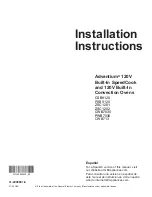
Suitable cookware and materials
Cookware / Material
Microwave
Grilling
Defrost-
ing
Heating Cook-
ing
Ovenproof glass and porcelain (with
no metal components, e. g. Pyrex,
heat-proof glass)
X
X
X
X
Non-ovenproof glass and porce-
lain
1)
X
--
--
--
Glass and glass ceramic made of
ovenproof / frost-proof material (e. g.
Arcoflam), grill shelf
X
X
X
X
Ceramic
2)
, earthenware
2)
X
X
X
--
Heat-resistant plastic up to 200 °C
3)
X
X
X
--
Cardboard, paper
X
--
--
--
Clingfilm
X
--
--
--
Roasting film with microwave safe
closure
3)
X
X
X
--
Roasting dishes made of metal, e. g.
enamel, cast iron
--
--
--
X
Baking tins, black lacquer or silicon-
coated
3)
--
--
--
X
Baking tray
X
X
X
X
Browning cookware, e. g. crisp pan
or crunch plate
--
X
X
--
Ready meals in packaging
3)
X
X
X
X
1)
With no silver, gold, platinum or metal plating / decorations
2)
Without quartz or metal components, or glazes which contain metals
3)
You must follow the manufacturer’s instructions about the maximum temperatures.
X suitable
-- not suitable
Other things to think about…
• Food items have different shapes and
qualities. They are prepared in different
quantities. Because of this, the
necessary time and power for
defrosting, heating or cooking can
vary. As a rough guide:
double the
quantity = almost double the time.
• The microwave creates the heat
directly in the food. Because of this, all
places cannot be heated at the same
time. You must stir or turn the heated
dishes, especially with larger quantities
of food.
• The
standing time
is given in the
tables. Let the food stand, in the
www.electrolux.com
12













































